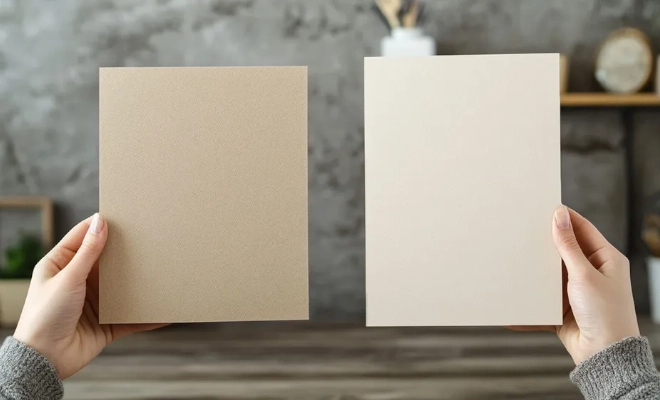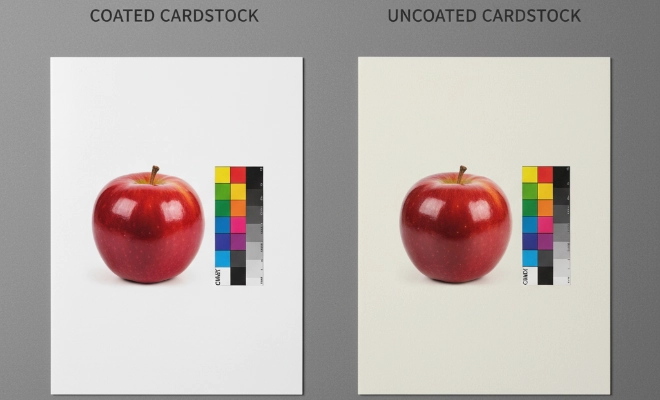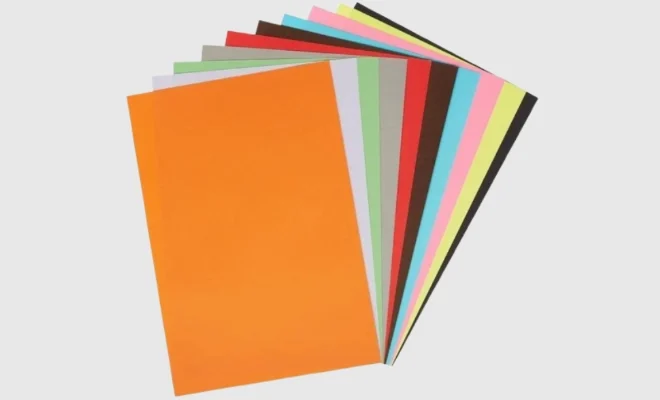Cardstock is a type of thick and durable paper. It is heavier than regular printing paper but thinner and more flexible than cardboard.
Cardstock is commonly used in crafts, business cards, invitations, greeting cards, brochures, and other stationery items. It’s also popular in packaging, scrapbooking, and professional printing because of its smooth finish and strength.
Understanding cardstock is important because its thickness, weight, and finish affect how your project looks and feels. This guide explains what cardstock is, its types, thickness, finishes, and common uses, so you can choose the right option for your projects.
What is Cardstock Paper?
Cardstock paper is sturdy yet flexible. It is thicker than printer paper but still easy to cut and fold with standard tools.
It is also known by other names, such as cover stock or pasteboard, which are commonly used in the printing and packaging industries.
Card Stock vs. Cover Stock

Both terms are similar to each other. The only difference between cardstock and coverstock is that when cardstock is coated, it turns into coverstock.
Types of Card Stock
Cardstock comes in a wide range of types, each serving a unique purpose.
- Glossy and metallic cardstock: Best for vibrant, eye-catching prints.
- Matte and textured cardstock: Gives a premium, elegant look.
- Specialty cardstock: Includes glitter, kraft, or patterned paper, often used for invitations, crafts, and eco-friendly packaging.
Thickness of Cardstock
The thickness of cardstock is measured in pounds (lb), points (pt), or grams per square meter (gsm). Higher values mean thicker and sturdier paper.
Compared to printer paper, cardstock is stronger and heavier. Unlike cardboard, which is much thicker and used mainly for shipping boxes, cardstock is smoother and better suited for printing and stationery projects.
| Pound (lb) | Point (pt) | GSM (g/m²) | Common Use |
| 65 lb | 9 pt | ~175 gsm | Light crafts, flyers, inserts |
| 80 lb | 10 pt | ~215 gsm | Greeting cards, brochures |
| 100 lb | 12 pt | ~270 gsm | Postcards, report covers |
| 110 lb | 13 pt | ~298 gsm | Business cards, high-quality prints |
| 130 lb | 16 pt | ~350 gsm | Premium invites, heavy covers |
| 160 lb | 20 pt | ~435 gsm | Packaging, thick presentation cards |
Finish and Textures
Cardstock paper comes in different finishes and textures, such as matte, glossy, smooth, or textured.
- Matte provides a soft, non-shiny look that feels subtle and elegant.
- Glossy offers a shiny, reflective surface that improves color vibrancy.
- Smooth delivers sharp and clear printing results for detailed designs.
- Textured options like linen or vellum add depth and give a premium feel.
Coated vs. Uncoated Cardstock

Here are the main differences between coated and uncoated cardstock:
- Coated cardstock: Has a shiny surface that makes colors appear brighter. Available as C1S (coated on one side) or C2S (coated on both sides). Best for photos, brochures, and packaging.
- Uncoated cardstock: Has a natural feel and is easier to write on. Often used for invitations, business cards, and stationery.
Uses of Cardstock Paper
Cardstock is one of the most versatile paper materials. Its strength, flexibility, and print quality make it popular in many areas:
- Crafting: Cardstock paper is widely used in crafting, such as scrapbooking, die-cutting, and making paper flowers.
- Stationery: It is popular in stationery, where it is used for greeting cards, invitations, and thank-you cards.
- Printing: In printing, cardstock works well for business cards, menus, and brochures.
- Packaging: It is also used in packaging. Custom boxes are used to pack electronics, cosmetics, and gift items.
- Schools and offices: In schools and offices, cardstock helps make flashcards, charts, and project materials.
- Decoration: For decorations, it is often used to create banners, party decor, and wall art.
Why Choose Cardstock Material for Custom Boxes?
Cardstock is a smart choice for custom boxes because it is lightweight, foldable, and cost-effective. Its smooth surface allows for high-quality printing of logos and colors, making it ideal for branding.
These boxes work well for cosmetics, jewelry, stationery, and gift items. With many finishes and textures available, cardstock packaging looks professional and premium.
Conclusion
Cardstock is thicker than normal paper yet easier to handle than cardboard. Its versatility makes it perfect for crafts, stationery, printing, and packaging. Strong, flexible, and customizable, cardstock is a practical choice for both personal and professional projects.

